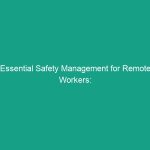Introduction
Good morning team! Today, we are going to discuss something that affects all of us in our daily tasks—complacency. As we navigate through our routine jobs, it’s easy to fall into a rhythm where we might overlook crucial Safety protocols. The purpose of this Toolbox Talk is to highlight the essential tips to combat complacency in routine tasks and stay vigilant. Understanding this topic is vital not just for compliance but for ensuring our health and Safety on the job.
Understanding Complacency
Complacency refers to a state of self-satisfaction accompanied by a lack of awareness of potential dangers. In the workplace, this can mean becoming so accustomed to our tasks that we stop paying attention to safety protocols and the Environment around us. This phenomenon can have serious repercussions, leading to accidents and injuries that could have been avoided.
Many employees believe that routine tasks pose minimal risk, but this mindset can be dangerous. The reality is that most workplace incidents occur during routine operations when employees let their guard down. Recognizing the signs of complacency and understanding its impacts is the first step toward fostering a safer work environment.
Key Hazards, Risks, and Safety Considerations
Complacency can lead to several Hazards, including:
- Ignoring Safety Protocols: Employees may skip essential steps in safety Procedures, assuming that they already know how to proceed.
- Overconfidence: Familiarity with tasks can lead to overconfidence, making employees less cautious.
- Lack of Awareness: Employees may fail to notice changes in their environment that might pose new risks.
The consequences of ignoring these risks can be severe. For instance, a simple oversight in wearing protective gear during routine Maintenance can result in serious injuries. We must remain vigilant and mindful of our surroundings to prevent such incidents.
Best Practices, Procedures, & Actionable Advice
To combat complacency, here are some Best Practices to incorporate into your daily routines:
1. Stay Educated and Trained
Regular Training sessions are crucial to keep safety at the forefront of your mind. Ensure you are up-to-date on safety protocols and procedures relevant to your role. This not only reinforces knowledge but also highlights the importance of vigilance.
2. Take Regular Breaks
Fatigue can lead to decreased attention and increased complacency. Schedule regular breaks to refresh your mind and body. Use this time to step away from your tasks and return with a clearer focus.
3. Engage in Safety Conversations
Encourage open discussions about safety with your colleagues. Share experiences and insights on potential hazards. These conversations can help reinforce the importance of staying alert.
4. Use Checklists
Implementing checklists for routine tasks can remind you of essential Safety Measures. Checklists help ensure that no steps are overlooked, fostering a habit of thoroughness.
5. Observe and Report
Always be on the lookout for hazards or changes in your environment. If you notice something unusual, report it immediately to your supervisor. This proactive approach can prevent accidents before they happen.
6. Encourage Peer Accountability
Look out for each other. If you see a colleague becoming complacent, gently remind them of the safety protocols. A culture of mutual accountability can significantly enhance Workplace Safety.
7. Reflect on Past Incidents
Reviewing past incidents or near-misses can provide valuable lessons. Understanding what went wrong and how complacency played a role can reinforce the necessity of vigilance.
Regulations, Standards, and Compliance
It’s essential to be aware of and compliant with safety Regulations set forth by OSHA and other relevant organizations. These regulations exist to protect employees, and compliance is not just a matter of legal obligation; it’s about ensuring everyone’s safety. Regularly reviewing these Standards can help keep safety top of mind and prevent complacency.
Employee Engagement & Discussion
Now, I’d like to open the floor for some discussion. What safety challenges have you encountered related to complacency? Have you noticed any specific routines that tend to lead to complacency in your work? Sharing our experiences can help us all stay vigilant and improve our safety practices.
Conclusion & Key Takeaways
In conclusion, combating complacency in routine tasks is essential for maintaining a safe workplace. By staying educated, taking breaks, engaging in conversations about safety, and being proactive, we can significantly reduce the risks associated with complacency. Remember, safety is not just an individual responsibility but a collective effort. Thank you all for your attention today, and let’s commit to prioritizing safety in everything we do!


